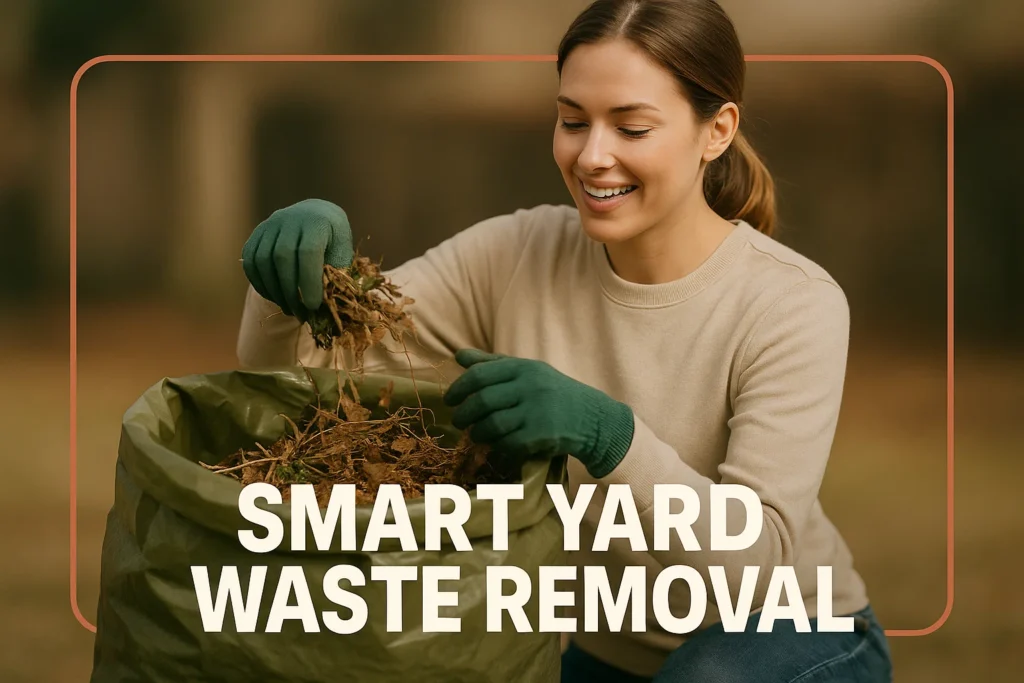Raking leaves, collecting clippings, cutting down trees and all the odds and ends of gardening add up to an annual chore. In no more than a few weeks of heavy rain or snow, yards and gardens can turn into one giant rubbish bin suitable only for a dump. However, if one could change all this tedium into an efficient process that not only keeps your outdoor space clean but is also good for the environment, then why not do it? Here are some smart strategies for getting rid of yard waste as a homeowner and doing the whole job right. Imagine spending less time fighting to move piles and more time smelling those bright blossoms.
Whether you are a getaway at the mercy of a great lawn or just tending to home base with a modest backyard, these clever tactics will help you get organized, reduce waste, and improve your soil’s health, all without making everyone else on your block jealous of your crummy old rubbish heap. Say goodbye to overwhelming yard debris and hello to a cleaner, greener space with these expert tips that every homeowner should know.
Understanding Yard Waste
The natural by-products of caring for outdoor spaces throughout a home are called yard waste. These include grass clippings, leaves fallen from trees, pruned branches and cut flowers, to name only some. Knowing exactly what constitutes yard waste would make a difference, as it establishes how to handle and dispose of it. Through proper identification, we can follow current local disposal rules for disposing of our environmental remains, but also crime prevention measures that protect natural beauty and yield clean energy.
The Importance of Proper Yard Waste Disposal
Properly disposing of yard waste can be more than just another cleanup chore. It is critical for both your personal safety and that of the surrounding neighborhood, while also being good for the environment.
- Clean ditches and stream banks that lessen flooding worries in your area.
- Fewer bugs and rodents can be achieved by cutting down their favorite breeding spots.
- Keep your neighborhood clean and visually appealing, boosting property values
- Promote waste management practices that benefit the environment through recycling and composting
- These steps turn leftover leaves and branches from possible eye sores or dangers into carefully managed resources.

Step-by-Step Guide to Easy and Affordable Yard Waste Removal
This title tells readers they’ll get a clear, structured process (step-by-step) and that it will be simple and affordable, which is exactly what your steps explain.
Step 1 – Know What Counts as Yard Waste
Yard waste can take many forms, and understanding this can be important for proper handling and disposal. This includes but is not limited to the following:
- Grass clippings and lawn trimmings
- Twigs: Small branches or shrubs after pruning
- Tree stumps (Special disposal rule applies if they don’t fit in bins.)
- Weeds, invasive plants (Always check municipal regulations)
Avoid putting the following in yard waste bins:
- Soil or dirt
- Rocks stones
- Pet feces
- Treated painted wood
Step 2 – Sort and Separate Yard Debris
Sorting your yard waste makes disposal and recycling more efficient:
- Leaves, grass clippings, and like debris can be placed in one collection bin.
- Remove any non-organic materials, such as plastic, garden wire, or trash
- Create piles of compostable materials, separate from bulky green waste for collection
- To make them easier to handle and meet curbside pickup requirements, flatten and tie any branches.
Step 3 – Use the Right Tools for Cleanup
Using proper equipment increases safety and makes the work of yard waste removal.
- You can collect leaves and grass clippings better with the help of a rake that has a wide head.
- Pruning shears and loppers are useful for cutting small branches.
- Hedge trimmers help tidy and manage shrubs.
- Wheelbarrows or garden carts can transport larger quantities of material more easily than carrying it by hand or with a cart.
- To protect yourself, always use gloves, safety goggles, and strong shoes.
- To further cut back on cleaning time and decrease the volume of waste, you can use specialized tools like leaf blowers or mulchers.
Step 4 – Yard Waste Disposal Options
Homeowners have several yard waste removal options depending on where they live and what they think is best for themselves:
- Curbside garbage pickup: Be mindful of the yard waste schedule in your city and stick to quantity limits
- Compost drop-off facilities: Many municipalities have free sites for yard waste disposal.
- Hiring a yard waste service: Good for substantial quantities or convenience
- Burning your lawn clippings: Ok in those places where it’s legal to burn safely
- Trash disposal: It’s ugly and usually an environmentally unfriendly last resort, but sometimes necessary if you live out in the middle of nowhere.
Step 5 – Eco-Friendly Yard Waste Solutions
Yard waste management for your garden in a sustainable fashion reaps benefits for both yourself and nature:
- Stack your prunings into a compost pile. In weeks, that mountain of clippings becomes dark, life-packed soil for your flowerbeds.
- Scatter shredded leaves directly onto garden beds. The layer preserves moisture, cools roots, and stops erosion all for free.
- Skip the bag of grass clippings. Mow your yard, and let the soft bits cover the turf. They rot down to feed your turf naturally, saving fertilizer cash.
- Ditch the bottle of chemical weed killer. Store-bought sprays creep into compost, ruining your hard work.
- If you have too many extra wood chips or mulch, consider donating them to community gardens or for landscaping projects.
Step 6 – Stay Safe While Removing Yard Waste
To prevent accidents and injuries while cleaning up your backyard, put safety first:
- Wear gloves, goggles, and other protective clothing as needed
- Make sure tools have good grips and a working guard on them
- Lift heavy bundles or individual objects properly to avoid back strain.
- Stay well-hydrated and take breaks whenever you start feeling tired
- For their own safety, keep children and pets away from active work areas

Tips for Reducing Yard Waste Long-Term
Reducing your yard waste will save on time spent on cleanup and will make your yard healthier. The tips that all homeowners should follow:
- Plant Native Species
Native plants do not need much trimming and water, and generate less debris.
- Use Ground Covers
Ground covers stop soil erosion and allow no weeds to grow, lessening wastage.
- Mow Less Frequently
Mow the lawn with fewer cuts but with a higher height of the blade to have good grass and minimal cutting.
- Practice Seasonal Pruning
Prune shrubs in the slow growth periods so as not to have piles of waste.
- Install Rain Gardens
Rain gardens take in storm water and eliminate erosion and debris runways.
- Mulch Regularly
Mulch garden beds to suppress weeds and keep the soil moist in order to reduce the waste in the yard.
- Compost Yard Debris
Turn leaves and clippings into compost instead of throwing them out.
- Choose Slow-Growing Plants
The shrubs and trees with slow growth require fewer pruning and generate less waste.
- Remove Weeds Early
Regular weeding thwarts going to seed and the generation of further waste by plants.
- Collect Leaves for Mulch
Instead of bagging leaves, shred them to use as natural mulch around plants.
Conclusion
These tips on simple yard waste cleanup will also assist you in maintaining a tidy and beautiful yard and reducing the volume of trash to be placed in the trash pile. Once you have the correct information, the correct tools, and the correct planet-conscious ways of doing things, yard cleanup ceases to be an uphill struggle and begins to pay back to you, your house and your entire neighborhood. Ready to elevate your yard cleanup? Give Go Go Junk Removal a call for a quick and professional yard waste pick up to help take the load off your shoulders.
FAQ’s
In general, leaves, grass clippings, small branches and prunings are ideal. No dirt, no rocks and nothing non-organic.
Regular cleaning will depend on the size of your yard and the season, but try to clean at least weekly if not biweekly to avoid buildup.
Yes, composting is an environmentally sound solution to repurposing leaves, grass clippings and garden waste into rich soil.
There are a lot of places where burning is limited in certain ways, so always check to be sure about local rules and safety when it comes to burning debris.
If it’s very large pieces of wood, it may need to be brought to a special pickup or drop-off location; You may want to look into having it professionally removed.





